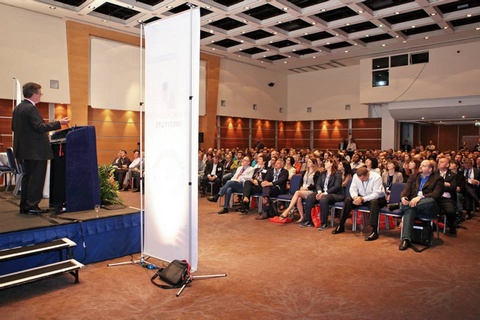Localization trends and localization of trends: a summary of Localization World-2013
 Recently, my colleagues and I attended a conference for those involved in the localization of everything in the world - Localization World . There are not so many specialized events for translators. There are events for freelancers, there are scientific - for example, annual TAUS conferences, there are industry-specific - like LegalTech. Localization World is the only event that brings together those who make translations, who order them and who develop technologies for this area. It discusses technologies, tools, statistics systems, services, and much more, without which the translator can live, but difficult.
Recently, my colleagues and I attended a conference for those involved in the localization of everything in the world - Localization World . There are not so many specialized events for translators. There are events for freelancers, there are scientific - for example, annual TAUS conferences, there are industry-specific - like LegalTech. Localization World is the only event that brings together those who make translations, who order them and who develop technologies for this area. It discusses technologies, tools, statistics systems, services, and much more, without which the translator can live, but difficult.Localization World started in the early 2000s - the first meeting took place in the fall of 2003 in Seattle, and has since been sold out. At first, the conference was not annual, but now experts are gathering at two or three LocWorld a year, in 2013, meetings were already held in Singapore and London, the last one - on June 12-14, and in early October, the event will be held in the US, in Silicon Valley. About 400-500 people come to events, which is quite a lot for the industry.
 So, what was discussed. In 2013, experts estimated the industry of translation services and technologies at more than $ 30 billion and noted a steady growth of 5-10% per year. In terms of technology, growth is even faster. Companies in the industry are attracting a significant number of investments; patent trolls in the United States have moved to action on our subject. Experts believe that this area is becoming more mature, which, among other things, confirms the entry of many companies providing linguistic services to IPOs.
So, what was discussed. In 2013, experts estimated the industry of translation services and technologies at more than $ 30 billion and noted a steady growth of 5-10% per year. In terms of technology, growth is even faster. Companies in the industry are attracting a significant number of investments; patent trolls in the United States have moved to action on our subject. Experts believe that this area is becoming more mature, which, among other things, confirms the entry of many companies providing linguistic services to IPOs.Initially, the translation and localization industry developed most intensively in the United States. However, now, due to the redistribution of the global economy, Europe, representing a vibrant and promising multilingual environment, has begun to play a prominent role. For the same reason, the Asian market of translations shows a dynamic pace of development.
')
The structure of the industry today is as follows: there are about 30,000 professional companies operating in the market, offering various linguistic services. The market is highly fragmented - about 30 companies account for 20% of the turnover of the entire industry. It's nice that we (ABBYY Language Services) enter the first hundred. The most actively growing and gaining weight are companies that offer technological solutions for managing and automating translation processes.
Localization World speakers highlighted the key factors that influence the market in the most significant way.
- Globalization of the market - before the company wanted to work in one or two local markets, and now apply all ten, and even more
- The explosive growth of content production - it provides the Internet with all the consequences.
- The continuous flow of information instead of individual projects - previously all necessary materials were collected to localize the site, they were translated, prepared and published, after which the project was considered completed. Now the flow of projects for localization can be continuous. The main reason is the constant need for updates. In such a situation it is difficult to talk about a single project — rather, it is continuous localization, which becomes an important part of the entire production process. We have already described the case , which perfectly illustrates this trend.
- The fundamental contradiction is the time-cost-quality - the traditional engine of progress.
 Reduction of the production chain with the development of technology - building the process of translation and communication with performers, as well as the quality of services, requires a separate large competence on the part of specialists. Conditionally, the workflow consists of the following steps: the manager takes the project from the client and sends in turn to the translator, editor and proofreader, while monitoring the quality of implementation at each stage. Now, thanks to various platforms and technological solutions, the chain of involved persons is reduced: project managers of a separate company are able to directly control the process.
Reduction of the production chain with the development of technology - building the process of translation and communication with performers, as well as the quality of services, requires a separate large competence on the part of specialists. Conditionally, the workflow consists of the following steps: the manager takes the project from the client and sends in turn to the translator, editor and proofreader, while monitoring the quality of implementation at each stage. Now, thanks to various platforms and technological solutions, the chain of involved persons is reduced: project managers of a separate company are able to directly control the process.
The conference participants noted another important trend: many companies are thinking about centralizing and consistently managing linguistic assets - corporate glossaries, translation memory bases, specialized machine translation engines - in general, all the tools that help save time and increase productivity in organizing and conducting translation activities . Previously, in most cases, linguistic service providers were involved in this task: translation companies and sometimes final performers (translators, editors, proofreaders), because they are the ones who work directly with the text and are not averse to making their lives easier for their clients. It is no secret that translators and bureaus can change, and companies need high-quality translations all the time. Therefore, in many cases, customers conduct the necessary bases on their own: at the beginning of each project, it is easier to share these resources with the contractor instead of a long training and introduction. In addition, the consistent management of linguistic assets makes it possible and creates the basis for the introduction of new technologies. In general, such work helps to automate the translation process, increase efficiency and reduce costs. Here we can conditionally identify four key areas:

- Terminological glossaries - recently, the importance of setting up terminological bases, purposeful and consistent accumulation of corporate terminology and systematization of the data has grown considerably.
- Style guides - formalized rules and requirements for company texts. Their use allows you to create clear texts and control their quality. As rules, grammatical and stylistic restrictions can be used, which help to process texts both at the input and at the output of the translation process.
- Translation memories are databases containing previously translated text segments (phrases, sentences). Companies strive to make this asset available to all performers who are working on a specific project.
- Machine translation - a couple of years ago it was a new trend, and many experts looked at it with caution. Now everyone understands that with large amounts of transfers one cannot do without it. However, as noted by most of the conference participants, MT is by no means a replacement of existing resources: many translators seriously fear that they will be replaced by a computer. Machine translation rather serves as a good complement to translation processes in companies. Currently, machine translation results are most often used by companies to understand the general meaning of the text. For professional use, machine translation results must go through a post-editing process.
Another important trend for the localization market is the growing importance of integration, cloud solutions and crowdsourcing. Many international companies have concluded that the introduction of these operations will help solve the traditional contradiction of speed, price and quality. Organizations acting as regular customers of large volumes of translations tend to integrate all production steps into the workflow as much as possible, and make the work available to all performers from anywhere in the world - all the necessary materials, corporate glossaries, Translation Memory databases and even projects themselves are placed in the cloud.
Since crowdsourcing involves the use of shareware resources, it is of particular interest to companies facing regular need for translations. However, if you do not offer the performers excellent motivation and convenient infrastructure, then such a story is unlikely to end with something good.
The story about trends turned out to be quite large, even though we tried to reduce it. Visitors should follow the photo to the Facebook page of LocWorld . For more details come to the comments. If you are at the October LocWorld in California, we will be happy to see you there!
Denis Frolov
ABBYY Language Services
Source: https://habr.com/ru/post/193468/
All Articles